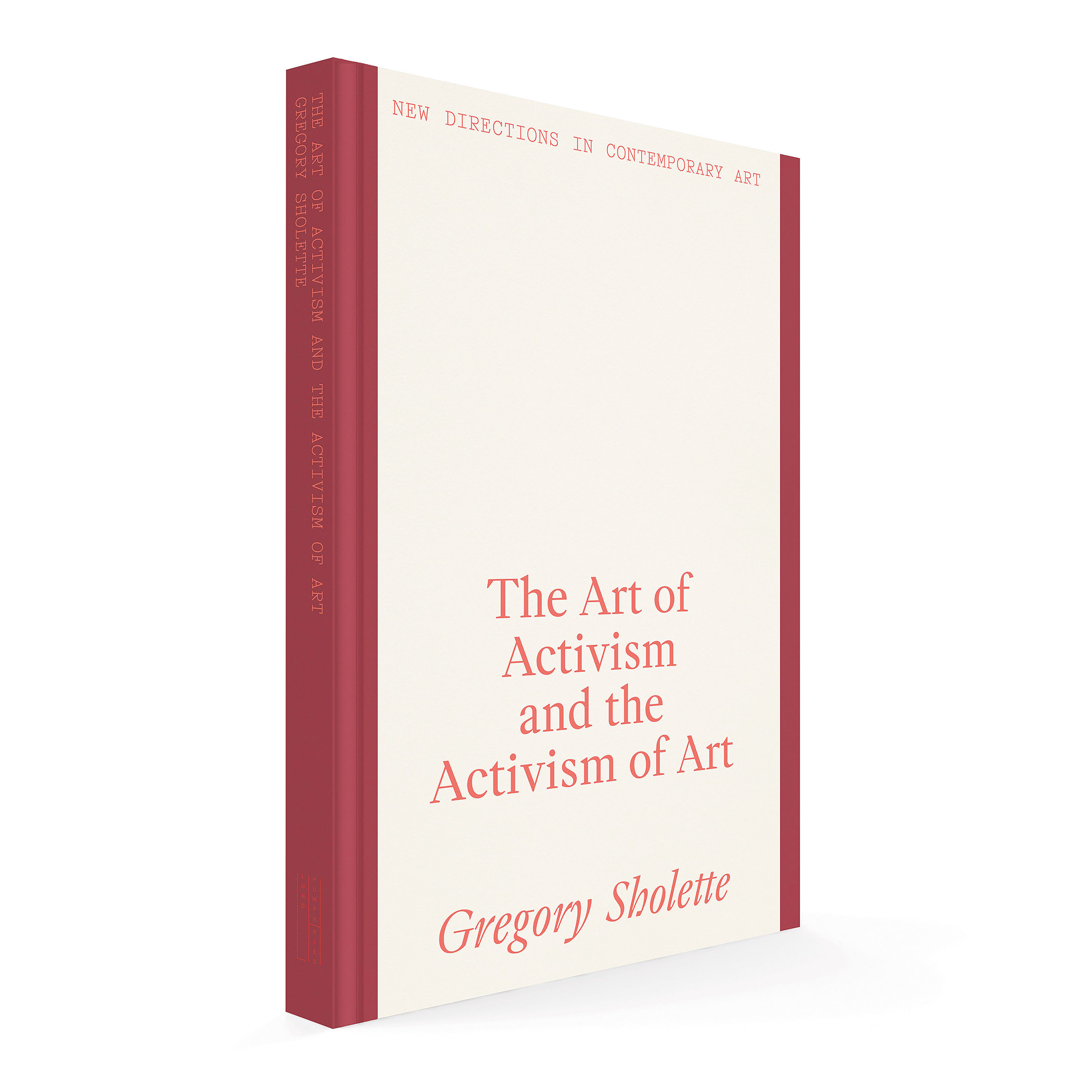> INTRODUCTORY CHAPTER <
THE ART OF ACTIVISM AND THE ACTIVISM OF ART Gregory Sholette 2022
Selected by The Art Newspaper (UK) as a top art books of 2022
You don’t decide to become an activist, somehow while watching the wounds of the world twirl around you, it seeps into the blood, commanding your attention and demanding actions that push against the tides of tradition. Sholette has focused all of his work, his teaching/writing and his life on confronting systems of power that left unchecked could destroy us all. Carrie Mae Weems
We live in cynical times where a critical stance often perversely sustains the oppressive power structure – just think about big biennales (Venice, Kassel…) full of manifestos against commodification and colonialism but perfectly fitting the art market. Such a situation calls for an analysis of the ambiguities that prevail in art activism – and Sholette does this in such a perfect way that his book should be massively distributed in all galleries as a reminder of where we are. Slavoj Zizek
Those of us who believe art can save us will find in Gregory Sholette’s new book further confirmation that science, politics, or philosophy are not enough to enact true change. But as the rich chapters of this marvelous book demonstrate there is a surge of artistic activism now that even the most conservative art establishments and institutions cannot ignore anymore. The Art of Activism and the Activism of Art is an indispensable book because it shows where serious art is taking place and how it can inspire true change also among other intellectual practices. Santiago Zabala, Professor of Philosophy Pompeu Fabra University
As a key member of the activist group Gulf Labor Coalition, Gregory Sholette has a unique perspective examin[ing] this fascinating subject “from the perspective of an artist andactivist who has been active in the field since the 1980s,” writes the art historian MarcusVerhagen in the introduction. This informed analysis spans more than 60 years of art activism,from the Situationist International group of social revolutionaries (1957-72), which directlyengaged with the student uprisings in Paris in May 1968, to Black Lives Matter today, which has “unquestionably set a new high bar for protest aesthetics”, Sholette says. Gareth Harris, The Art Newspaper
Even though the book is relatively short, it describes the means, objectives, aesthetics, trajectories and sometimes even the impact of activist art without ever falling into simplifications…Sholette describes his book as a “terse excursion”, I’d call it a tour de force. His history of activist art covers a period that goes from the 1960s to the early days of 2022. What I found remarkable is the ease with which his writing covers the economy, society, history and intellectual culture of a time to show how artists/activists responded to the socio-economic and cultural conditions of their time and how these same conditions would sometimes be affected by them. Regine Debatty, WE MAK$$$NEY NOT ART
This question of what distinguishes artist and activist has only become more muddled in our present moment, where new forms of spectacle emerge in strange forms of eternal return, continuing to interrogate how we collectively define what ‘art’ is, and where it ceases to exist as such. Rather than making decisive assertions as to what activist art is or will become, Sholette instead offers thoughtful observations on its historical foundations and evolving contemporary iterations. Alex Nicholls, FIELD Journal of Socially Engaged Art Criticism.
The Art of Activism and the Activism of Art is staged in punchy historical summaries of key movements and moments, from the Situationists’ influence on the events of May 1968 through the turn from conceptualism to feminist, Black radical and leftwing projects during the 70s, to the interventionism of collectives such as New York’s Group Material and the ‘culture jamming’ and ‘tactical media’ approaches of art groups during the 90s. J.J. Charlesworth in Art Review
TABLE OF CONTENTS
The Contemporary Artist as Activist: Not Just a Test
The Situationists’ Total Critique, and Total Cure
Grupo de Artistas de Vanguardia
Escaping the Long Greenbergian Shadow
The Phantom Archive of Social-Movement Culture
The Activist Turn in Art
Artists respond to the Neoliberal Turn
Repurposing Situationism as Tactical Media
Back to the Streets: From Tactical Media to Occupy Wall Street
Institutional Critique or Cultural Abolition?
Winter Is Coming/Winter Is Here
Black Lives Matter: Fugitivity in Plain Sight
Conjectures, Hauntologies, Inconclusions
Since the global financial crash of 2008, artists have become increasingly engaged in a wide range of cultural activism targeted against capitalism, political authoritarianism, colonial legacies, gentrification, but also in opposition to their own exploitation. They have also absorbed and reflected forms of protest within their art practice itself. The Art of Activism and the Activism of Art maps, critiques, celebrates and historicizes activist art, exploring its current urgency alongside the processes which have given rise to activism by artists, and activist forms of art.
 Art as Social Action: An Introduction to the Principles and Practices of Teaching Social Practice Art, 2018
Art as Social Action: An Introduction to the Principles and Practices of Teaching Social Practice Art, 2018
by Gregory Sholette, Chloë Bass, Social Practice Queens
Art as Social Action is both a general introduction to and an illustrated, practical textbook for the field of social practice, an art medium that has been gaining popularity in the public sphere. With content arranged thematically around such topics as direct action, alternative organizing, urban imaginaries, anti-bias work, and collective learning, among others, Art as Social Action is a comprehensive manual for teachers about how to teach art as social practice.
Along with a series of introductions by leading social practice artists in the field, valuable lesson plans offer examples of pedagogical projects for instructors at both college and high school levels with contributions written by prominent social practice artists, teachers, and thinkers.
Lesson plans also reflect the ongoing pedagogical and art action work of Social Practice Queens (SPQ), a unique partnership between Queens College CUNY and the Queens Museum.
“Art as Social Action . . . is an essential guide to deepening social art practices and teaching them to students.” ―Laura Raicovich, president and executive director, Queens Museum
Preview the Table of Contents Here
 Delirium and Resistance: Activist Art and the Crisis of Capitalism, Gregory Sholette, Pluto Press, 2016
Delirium and Resistance: Activist Art and the Crisis of Capitalism, Gregory Sholette, Pluto Press, 2016
Capitalist crisis does not begin within art, but, as Gregory Sholette argues in Delirium and Resistance, art can reflect and amplify their ideas. In this follow-up to his influential 2010 book, Dark Matter: Art and Politics in the Age of Enterprise Culture, Sholette engages in critical dialogue with artists’ collectives, counter-institutions, and activist groups to offer an insightful, firsthand account of the relationship between politics and art in neoliberal society. Sholette lays out clear examples of art’s deep involvement in capitalism: the dizzying prices achieved by artists who pander to the financial elite, the proliferation of museums that contribute to global competition between cities in order to attract capital, and the strange relationship between art and rampant gentrification that restructures the urban landscape. With a preface by noted author Lucy R. Lippard and an introduction by theorist Kim Charnley, Delirium and Resistance draws on over thirty years of critical debates and practices both in and beyond the art world to historicize and advocate for the art activist tradition that radically—and, at times, deliriously—entangles the visual arts with political struggles.
“Read this book and you will never see contemporary art the same way again. So much of what’s wrong with the global economy is wrong with the establishment art world and Sholette has been examining this for a long time in everything he does as an art person. In the many art worlds that exist, we’re happy and proud to be a part of his.” – Guerrilla Girls
“Sholette is representative of a new artist type that emerged after Conceptualism in that his work as a critic, theorist, and curator is central to his practice as an artist. No-one else has come up with a category that rivals ‘dark matter’ as a hermeneutic for analysing the current political economy of art and the economic situation of artists, in all their variety. No-one else has quite the long-term commitment to collective practice or the record of publications on the theme. He is one of the most cogent artist-theorists currently working in the domain of social practice art.” – Andrew Hemingway, University College London
“Shifting between artistic practice, curating, writing, and activism, Sholette has been surfing the waves of activist art for more than three decades. His work is based on the multitude of lines drawn from the political art of the 20th century and expanding its realm as it reaches out to the transversal activisms of the 21st century. Delirium and Resistance is a manifesto documenting these developments in their broadest forms, from 1980s anti-gentrification efforts and 1990s tactical media practitioners, to the post-occupy-practices of our current circumstances.” – Gerald Raunig, author of DIVIDUUM: Machinic Capitalism and Molecular Revolution, Part 1
Available from University of Chicago Press
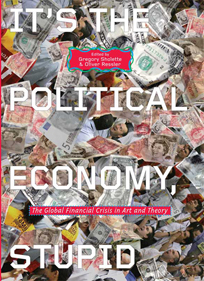 It’s The Political Economy Stupid: Edited by Greg Sholette and Oliver Ressler, Designed by Noel Douglas, Pluto Press, 2013
It’s The Political Economy Stupid: Edited by Greg Sholette and Oliver Ressler, Designed by Noel Douglas, Pluto Press, 2013
It’s the Political Economy, Stupid brings together internationally acclaimed artists and thinkers, including Slavoj Žižek, David Graeber, Judith Butler and Brian Holmes, to focus on the current economic crisis in a sustained and critical manner.
In sympathy with the subject matter, the book features powerful original artwork for the cover, and an internal design theme based on the movements of Goldman Sachs stock market values by activist designer Noel Douglas. What emerges is a powerful critique of the current capitalist crisis through an analytical and theoretical response and an aesthetic-cultural rejoinder. By combining artistic responses with the analysis of leading radical theorists, the book expands the boundaries of critique beyond the usual discourse.
It’s the Political Economy, Stupid argues that it is time to push back against the dictates of the capitalist logic and, by use of both theoretical and artistic means, launch a rescue of the very notion of the social.
“Confrontational, intellectual, and occasionally amusing group show, which squarely aligns itself with the Occupy movement.” – Village Voice (praise for the exhibition on which the book is based)
“In the wake of the capitalist crisis, very few cultural institutions have dared to address the horrors of greed that plague us in such a direct and haunting way.” – Alexander Cavaluzzo, Hyperallergic.com
Review by Martin Patrick for Art Monthly
Review by William Powhida for Hyperallergic.com
Review by Pascal Porcheron for The Grim Dance
Review by Milena Placentile for Canadian Dimension
Excerpts found here
Available from Pluto Books
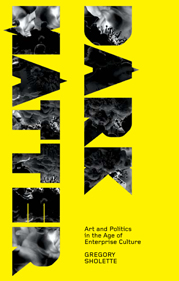
Dark Matter: Art and Politics in the Age of Enterprise Culture, Gregory Sholette, Pluto Press, 2010
Radical Social Production and the Missing Mass of the Contemporary Art World Gregory Sholette (Pluto Press UK, 2009.) The premise of this book is that the formal economy of contemporary art is dependent upon a previously suppressed sphere of informal, non-market, social production involving systems of gift exchange, cooperative networks, distributed knowledge, and collective activities, which is becoming increasingly visible and potentially threatening to the symbolic and fiscal cohesion of high culture, especially in its most politicized form as interventionist art.
For more on Dark Matter visit: darkmatterarchives.net
Published in Spanish Here
For an Additional 20% off use Promotional Code:P356ED
buy the new paperback here:
amazon
pluto books
“Based on a multitude of examples from the heterocosmos of invisible art practices, Dark Matter is the ultimate companion to contemporary activist art. In his exquisite and theoretically informed style Gregory Sholette investigates the problematic functions of art practices in the processes of neoliberal appropriation, but above all the wild explosive, and deterritorializing lines that are drawn in the dark matter between art and politics.”
Gerald Runig, philosopher, art theorist and author of Art and Revolution.
“With great verve and urgency, Gregory Sholette explores the economics of contemporary art production in an era of neoliberalism, and outlines the promises and pitfalls of various tactics of resistance. Dark Matter is a salient call-to-arms to all cultural laborers.”
Julia Bryan-Wilson, art historian and author of Art Workers: Radical Practice in the Vietnam War Era.
“As both active participant and witness Greg Sholette sheds a welcome and overdue light on the dark matter of the so-called art world.”
Hans Haacke.
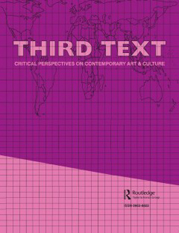 Third Text, Volume 22 Issue 5 September 2008
Third Text, Volume 22 Issue 5 September 2008
Special Issue ” Whither Tactical Media” edited by Greg Sholette & Gene Ray. Critical perspectives on contemporary art and culture.
PDF found here
www.thirdtext.com
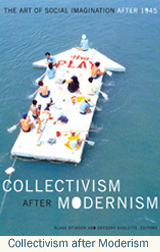 Collectivism After Modernism: Art and Social Imagination after 1945
Collectivism After Modernism: Art and Social Imagination after 1945
Blake Stimson and Gregory Sholette, editors. (University of Minnesota Press, 1997.) With contributions by, Irina Aristarkhova, Jesse Drew, Okwi Enwezor, Ruben Gallo, Chris Gilbert, Brian Holmes, Alan Moore, Jelena Stojanovic, Reiko Tomii, and Rachel Weiss.
“To understand the various forms of postwar collectivism as historically determined phenomena and to articulate the possibilities for contemporary collectivist art production is the aim of Collectivism after Modernism. The essays assembled in this anthology argue that to make truly collective art means to reconsider the relation between art and public; examples from the Situationist International and Group Material to Paper Tiger Television and the Congolese collective Le Groupe Amos make the point. To construct an art of shared experience means to go beyond projecting what Blake Stimson and Gregory Sholette call the “imagined community”: a collective has to be more than an ideal, and more than communal craft; it has to be a truly social enterprise. Not only does it use unconventional forms and media to communicate the issues and experiences usually excluded from artistic representation, but it gives voice to a multiplicity of perspectives. At its best it relies on the participation of the audience to actively contribute to the work, carrying forth the dialogue it inspires”
Philip Glahn, Bomb Magazine
PDF found here
www.stmarksbookshop.com
www.upress.umn.edu
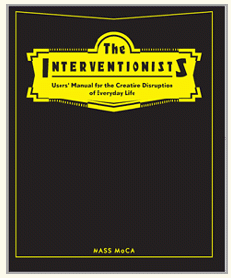 The Interventionists: Users Manual for the Creative Disruption of Everyday Life
The Interventionists: Users Manual for the Creative Disruption of Everyday Life
Nato Thompson and Gregory Sholette editors. (Mass MoCA/MIT Press 2004, & 2005). With graphics by Arjen Noordeman, and contributions by Nicholas Mirzoeff, and Ondine C. Chavoya.
Art made to attach to buildings or to be given away? Wearable art for street demonstrations or art that sets up a booth at a trade show? This is the art of the interventionists, who trespass into the everyday world to raise our awareness of injustice and other social problems. These artists don’t preach or proselytize; they give us the tools to form our own opinions and create our own political actions. The Interventionists, which accompanies an exhibit at MASS MoCA, serves as a handbook to this new and varied work. It’s a user’s guide to art that is exciting, provocative, unexpected, inspiring (artistically and politically), and fun. From Michael Rakowitz’s inflatable homeless shelter and William Pope.L’s “Black Factory” truck with pulverizer, gift shop, and giant inflatable igloo to the Biotic Baking Brigade’s political pie-throwing, the art of The Interventionists surveys a growing genre and offers a guide for radical social action.
 Gregory Sholette Selected Projects 1980-2003 16 pages, color 8.5″ x 11″, published by Colgate University, NY
Gregory Sholette Selected Projects 1980-2003 16 pages, color 8.5″ x 11″, published by Colgate University, NY
 As Radical as Reality Itself
As Radical as Reality Itself
Essays on Marxism and Art for the 21st Century edited by Matthew Beaumont, Andrew Hemingway, Esther Leslie, Esther, and John Roberts. (Peter Lang Publishers, Belin, 2007.) This volume includes the long version of Gregory Sholette’s essay “Dark Matter and the Counter Public Sphere
 Visual Worlds
Visual Worlds
Blake Stimson, John R. Hall & Lisa T. Becker editors (Routledge, 2005). A collection of essays on visual culture that includes Gregory Sholette’s essay, “Heart of Darkness: a Journey into the Dark Matter of the Art World”
Note: this book is still very expensive. The essay included is also downloadable on my site here:gregorysholette.com
 Anarchitexts
Anarchitexts
A collection of texts edited by Joanne Richardson of SUBSOL (Autonomedia Press, 2004), and contains “The Folds of an Institution,” a conversation between Gregory Sholette, Brett Bloom, and Cesare Pietroiusti. Available from Autonomedia Press
This book and other books/papers by Greg Sholette are also available from St. Mark’s Bookshop, New York City www.stmarksbookshop.com and Powels Books Chicago
